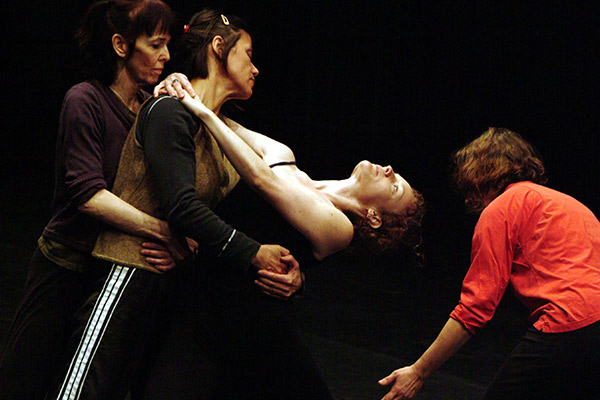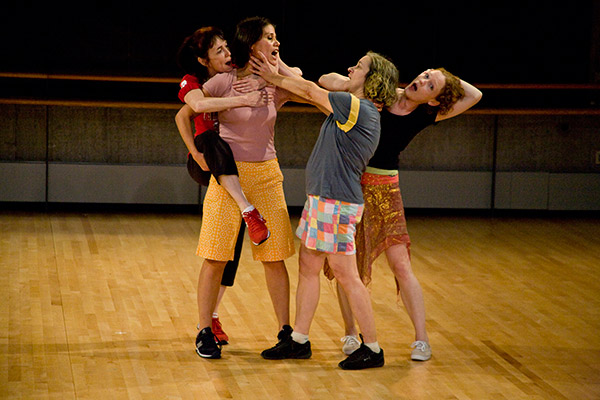Yvonne Rainer’s innovative choreography challenges both audiences and performers. Dancer Pat Catterson—who performs new work by Rainer at the Getty on October 3 and 4—reveals what it’s like to bring alive her “unadorned, direct performance of movement”
Performance of Yvonne Rainer’s Assisted Living: Good Sports 2 at DIA Beacon in 2011. Pat Catterson (far left) and Emily Coates in front; Patricia Hoffbauer (left) and Manou Phuon (right) in back. Photo © Paula Court
I first saw Yvonne Rainer’s work, including her Trio A and The Mind is a Muscle, in New York City, and first met and performed with her at the American Dance Festival at Connecticut College, all in 1969. In the next two years, I performed in her WAR and Grand Union Dreams and saw many performances by the Grand Union, the improvisational troupe she founded. I even participated in a few.
In a particularly memorable performance, I danced Trio A retrograde, and in the nude—save for an American flag tied around my neck. Yvonne made this version to protest the Vietnam War and the arrest of an artist and gallery owner who had dared to display an artwork incorporating the American flag, thereby “desecrating” it. In 1970 I also presented my own first full evening of choreography at Judson Memorial Church, then the epicenter of experimental dance in New York.
Yvonne stopped choreographing in the 1970s to focus on filmmaking, and did not resume until 2000. Other than performing a segment of Trio A—this time clothed—in a 1975 work of mine called Serial II, I didn’t perform Yvonne’s work again until October 4, 1999. In that evening at Judson Church, I, along with Yvonne, Steve Paxton, and Douglas Dunn, performed various versions of Trio A under the title Trio A Pressured.

Pat Catterson (foreground) performing Yvonne Rainer’s Trio A at Judson Church in 1999. Photo: Christian Uhl
Shortly after that momentous occasion, Yvonne was commissioned by Mikhail Baryshnikov to create a new work for his company, the White Oak Project, and she asked me to assist her. That work, After Many a Summer Dies the Swan, began not only a return to dance-making for Yvonne, but also a new working relationship for me with her that continues to this day.
Since returning to choreographing, Yvonne has created six new works with us, the Raindears, the nickname we dancers have given ourselves: AG Indexical with a little help from H.M., RoS Indexical, Spiraling Down, Assisted Living: Good Sports 2, Assisted Living: Do You Have Any Money, and this past summer, The Concept of Dust, or How do you look when there’s nothing left to move. The current Raindears are Emily Coates, Patricia Hoffbauer, Emmanuele Phuon, Keith Sabado, and myself. (Choreographer Sally Silvers was an original member of the group but left in 2009 to focus on her own career.) Including Yvonne, each of us is in a different decade of life, from the thirties to the seventies. At 68, I am the oldest of the Raindears.

The Raindears perform Yvonne Rainer’s Agon Indexical with a little help from H.M. in Helsinki, circa 2008. Left to right: Pat Catterson, Patricia Hoffbauer, Emily Coates, Sally Silvers

Pat Catterson performing Yvonne Rainer’s Trio A at the Museum of Modern Art in 2009. Photo: Yi-Chun Wu
Yvonne’s choreographic strategy for all of these pieces has been similar, and similar to what I recall of the dances from the seventies in which I participated. She calls her mode of assembling “radical juxtaposition,” always with an eye to making sure there is “a fly in the ointment,” for she never wants the viewer to get too comfortable. The resulting clear but challenging forms allow meaning to poetically emerge from this conjoining, the dance’s significance left open to the viewer’s imagination and historical perspective.
To begin her collage-like process, Yvonne arrives at rehearsal armed with various materials: segments of new set movement to teach us, movement quotes from her earlier work, images from photographs, directives for structured improvisations, bits of text, often with political content or from her current readings, sometimes music, and—often now—videotapes of others’ artwork. Recently, for example, she brought in the film routines of Stan Laurel and Oliver Hardy and the brilliant physical acting of Jacques Tati. This process for us, the dancers, often entails homework. For me, as her rehearsal assistant, it means learning movement from videotapes and then teaching this to the others, or studying music scores for structural landmarks or counts.

The Raindears perform Yvonne Rainer’s Spiralling Down at Baryshnikov Art Center in 2011. From left: Pat Catterson, Patricia Hoffbauer, Sally Silvers, and Emily Coates. Photo: Andrea Geyer
Yvonne’s work, because of its pastiche nature, and its sometimes more mental than organic arrangement, requires the dancer to switch energies on a dime. It can also be hard to remember. One needs as much mental as physical alertness and absorption, and the challenge is to not let the mental effort increase the body’s tension.
There are stylistic elements and aesthetic preferences in Yvonne’s work to attend to as well. As in her early work, characterized as epitomizing the notion of “the neutral doer,” she prefers an unadorned, direct performance of movement, with a weighted ease more pedestrian- or athletic-looking than technical. Though sometimes requiring technique skills, we are to perform without stylistic furbelows or stance or personal expression—that is, unless she specifically requests we do otherwise, perhaps as a kind of quote or framing of a clichéd style or genre of expression.
Within this, we dance as our individual selves, not as generically molded dancers or as particular characters. As with any choreographer’s work, one has to find one’s own way within this so as to be able to perform it, rather than fake its engagement or merely deliver it as a list of disconnected orders. This is not about finding a personal emotional expression, necessarily, though this can happen, but more about finding some kind of a through line that allows one to find, at least, a physical logic.
Performing Yvonne’s work is an enrapturing engagement of mind and body, one both similar and different from what my own work brings me. I am grateful for its challenges and to Yvonne for continuing to ask me to perform, even in my seventh decade.
_______
This piece is adapted and updated from the essay “Dancing Yvonne,” published in 2007 in Attitude Magazine.
See Pat Catterson perform two works by Yvonne Rainer, co-commissioned by the Getty and Performa in conjunction with the current Getty Research Institute exhibition Yvonne Rainer: Dances and Films, at the Getty Center on October 3 and 4.




Comments on this post are now closed.
Trackbacks/Pingbacks